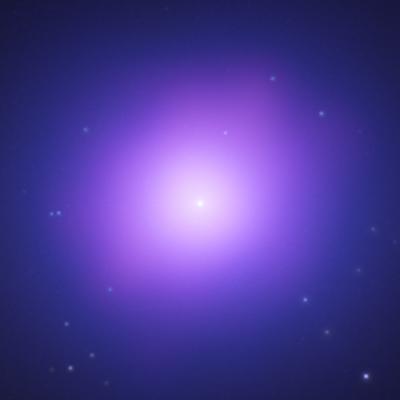[/caption]
Working out the mass of huge black holes, like the ones hiding in the centre of galactic nuclei, is no easy task and attempts are being made to find novel ways to weigh them. Using data from the Chandra X-ray Observatory, two scientists have confirmed a theory they conceived ten years ago, that the supermassive black holes in the centre of galaxies strongly influence the nature of the gases surrounding them. So, acting like a remote thermometer, Chandra is being used to probe deep into the neighbourhood of these exotic objects, gauging their masses very accurately…
The supermassive black hole at the centre of NGC 4649 is a monster. It is about 3.4 billion times the mass of the Sun and a thousand times bigger than the black hole at the centre of the Milky Way. This fact makes it an ideal candidate to test new methods of measuring the mass of black holes to see how the results correlate with traditional methods. With a high degree of accuracy, scientists have proven that a previously untested theory of weighing black holes works by using the Chandra X-ray telescope.
Until now, supermassive black hole masses have been measured by observing the motions of stars and gas deep inside galactic nuclei, now astronomers are using the gravitational influence of the black hole over the hot gas trapped around the singularity. As the gas is pulled slowly toward the black hole, it is compressed and heated. The bigger the black hole, the higher the peak temperature. Chandra has been used to measure the peak temperature of the gas right in the centre of NGC 4649 to find the derived mass is identical to the mass previously measured by traditional means.
Fabrizio Brighenti from the University of Bologna in Italy, and William Mathews from the University of California at Santa Cruz have been working on this research for the past decade. It is only now, with the availability of a telescope as powerful as Chandra that these observations have been possible.
“It was wonderful to finally see convincing evidence of the effects of the huge black hole that we expected. We were thrilled that our new technique worked just as well as the more traditional approach for weighing the black hole.” – Fabrizio Brighenti
The black hole inside NGC 4649 appears to be in a dormant state; it doesn’t seem to be pulling in material toward its event horizon very rapidly and it isn’t generating much light as it slowly grows. Therefore, using Chandra to indirectly measure its mass by sensing the peak temperature of surrounding matter is required to weigh it. In the early universe, huge black holes such as these will have generated dramatic displays of light. Now, in the local Universe, such black holes lead a more retiring life, making them difficult to observe. This prospect excites the lead scientist on the project, Philip Humphrey. “We can’t wait to apply our new method to other nearby galaxies harboring such inconspicuous black holes,” he said.
Source: Physorg.com


“Fabrizio Brighenti from the University of Bologna in Italy, and William Mathews from the University of California at Santa Cruz have been working on this research for the past decade. It is only now, with the availability of a telescope as powerful as Chandra that these observations have been possible.”
>>>Great result for them (and all of us)! Should be a very useful technique. I wonder why it took them ten years to test it though; Chandra has been flying for almost that long itself now…
You have a point, Astrofiend: could it be that it took a while to get ‘scope time’ for their observations, or they needed to convince themselves of the robustness of their theory before speaking to others to help make the observations?
Space physics is a rather small community. You want to ensure any new theory is pulled apart and put back together several times, and if possible try to find someone to validate your work before releasing it. Even a small mistake in any calculation can hurt your reputation; a full blow miss is nearly a death blow.
how can mass of black holes can weigh just by knowning temperature surrounding them(black hoels) ?is it possible?and what the method?